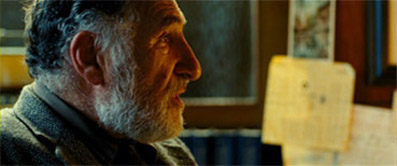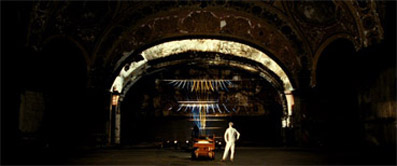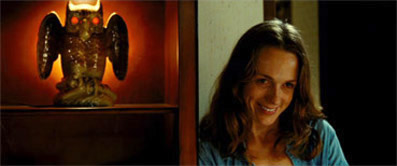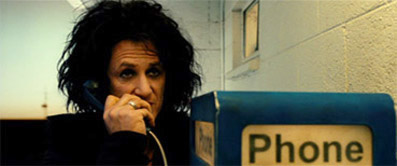| |
"As far as I'm concerned, every film has to be an unrelenting hunt for the unknown and for mystery, not so much to find the answer, but to keep the question alive." |
| |
Paolo Sorrentino |
Questions, and many of them, swirl inside the mind of Cheyenne (an excellent Sean Penn), a 50-year-old former rock star living in Dublin. From the moment Cheyenne comes on screen, it's clear he never stops thinking, forever preoccupied. You can almost hear the cogs whirring in his brain. A boy who never really grew up, he's still pondering the big questions: Who am I? Where's my place in the world? Why am I here? This Must Be the Place, the English language debut of acclaimed director Paolo Sorrentino chronicles Cheyenne's journey as he attempts to find the answers to all these things, but mostly, he just finds himself asking more questions.
Dressed entirely in black, with heavy make-up and backcombed hair modelled after The Cure's Robert Smith, Cheyenne's character was directly inspired after lifelong fan Sorrentino saw present-day Smith in concert. Though Cheyenne's heyday in the '80s has long gone, and he's been ravaged by the excesses of drink and drugs, he still stands out everywhere, drawing attention for what he looks like as well as who he is. Though happy with his lot and still very much in love with his wife Jane (Frances McDormand in a brief, but powerful performance), Cheyenne is drifting with no real purpose. Timid and soft-spoken, he's also grown fearful of everything outside the safety of the world he's come to know. Ambling around with sidekick Jeffrey (a wonderful Simon Delaney), he no longer plays music, preferring to dole out advice to those around him. Aside from Jeffrey and Jane, his only friend is a young local girl Mary (Eve Hewson, making her debut), who's something of a kindred spirit. However, Cheyenne's world is about to be turned upside down and his horizons will be well and truly expanded in more ways than one.

When he learns that his ailing father is close to death, he packs his suitcase and heads to New York, in the hope of seeing him one last time and repairing their strained relationship. Afraid of flying, he's forced to travel by ship instead. By the time he arrives home, his father has already passed away. Reeling, Cheyenne attempts to reconnect through reading his father's journals, and learns of his attempts to find Aloise Lange (Heinz Lieven), an SS guard who persecuted him during his time at Auschwitz. In his father's absence, Cheyenne takes up the mantle, first heading to New York in search of famed Nazi hunter Mordecai Midler (Judd Hirsch), a friend of his father's. Mordecai is now reluctant to keep looking for Lange, weary from his own years of searching, but Cheyenne is determined to carry on. Though unsure of exactly why, the desire to find Lange is too strong to ignore, and he sets out on his own journey, with only his father's journals and a pick-up truck at a his disposal.
In under two hours, this quirky road movie manages to explore more than films afforded bigger budgets and longer running times. In fact, there's enough material here for two or even three films (something which is shown in the alternate cuts of the film and the deleted scenes, both of which are discussed below). It carries an energy that's at odds with Cheyenne's comparative lethargy, and that's what makes it so interesting. Stylistically and thematically, This Must Be the Place is just about as far as you can get from Sorrentino's previous film, the Oscar winning international breakthrough Il Divo. Where that and its predecessors L'uomo in più / Man Up, Le conseguenze dell'amore / The Consequences of Love, and L'amico di famiglia / The Family Friend were distinctly Italian in flavour, This Must Be the Place is most certainly American while managing to retain Sorrentino's unique voice and penchant for the surreal. A film full of contradictions, it wears those differences like a proud badge of honour. One of the earliest sequences, with Mary head to toe in black (aside from her brightly coloured hair extensions) and riding a skateboard around the streets, is an early indicator that this is by no means an ordinary film.

Written by Sorrentino and his frequent writing partner Umberto Contarello, they make the most of the strangeness that exists only on the road: curios of giant pistachios and beer bottles, rundown motels, huge trucks, drifters and gamblers to render a vivid and affectionate picture. Like Wim Wenders, and many émigré filmmakers before him, Sorrentino has the perfect degree of distance to point his lens at American culture and have it reflect something different from the norm. It's ambitious and wide in scope and that's not just down to the beauty of the picture postcard vistas shot by Sorrentino's longtime collaborator, cinematographer Luca Bigazzi. The music too, is by no means the standard pop jukebox fare, composed specially for the film by David Bryne (who also makes a cameo appearance), with lyrics by Will Oldham (better known as Bonnie Prince Charlie). Music, rightly, is a character in its own right, and has a very particular identity that transcends Bryne's revered status. It's entirely bound to Cheyenne and his experience, even though the title of the film is borrowed from one of the most popular Talking Heads songs.
Exactly what kind of film This Must Be The Place is a difficult one to pin down. There are echoes of David Lynch's The Straight Story and of course, the seminal Lost Highway, with which Sorrentino's film shares many traits, including it's dark, genre-blending, sometimes nightmarish quality of roadside delirium, all hung within the frame of the road movie. Elsewhere there are touches of the picturesque found in Wim Wenders' Alice in den Städten / Alice in the Cities and Paris, Texas; the bittersweet tenderness of Jim Jarmusch's Broken Flowers, and just a touch of comic sensibility that's come to define the work of Emir Kusturica. Though the pop culture references and setting make it feel a thoroughly modern film, there's an undertone of nostalgia here, and it's not difficult to recall cinema of an earlier period, specifically The New Hollywood era and two of its landmark road movies, Hal Ashby's The Last Detail and Martin Scorsese's Alice Doesn't Live Here Anymore.

Essentially, these two genres shouldn't work, repellent as oil is to water. At first, the shift in tone is jarring – the phrase 'plot twist' has never felt more adequate. Going from Cheyenne and Jane playing squash in a drained out swimming pool, to hearing the voiceover of Cheyenne's late father talking about his camp experiences – or as he calls it 'The Inferno' – isn't quite as abrupt as the screech of brakes that accompanies Cheyenne's many stops on the road, but it's pretty close. For some, it'll be a change they can't recover from. However, it's to Sorrentino's credit that he makes it work. The clues are there from the beginning that there's more to this story, and more to Cheyenne than meets the eye, even before we see those dreaded iconic numbers tattooed on Cheyenne's father's arm.
Considering the weighty moral and emotional baggage that comes with representing Holocaust narratives, that's an incredibly difficult task, and you may be wondering if this is Holocaust lite, purely played out in a bid to be different. It is different, of course, but there's nothing cheap about Sorrentino and Contarello's approach. If anything, they bring a fresh perspective quite different from Bryan Singer's Apt Pupil, Stephen Daldry's The Reader or Gilles Paquet-Brenner's Elle s'appelait Sarah / Sarah's Key, that is more likely to encourage a continued dialogue, thereby keeping oratory history alive and ensuring the stories from those dark years aren't forgotten. The film makes a point of saying how important it is not to gloss over details or reduce the importance of historical events. One of the many reasons Cheyenne knows so little is because of his poor relationship with his father, not only because of his father's reluctance to talk, but also because of the way the subject was taught (or wasn't) to him in high school, something he questions his old teacher Dorothy about when he drops in on her during his trip. Dorothy admits it was something she preferred to 'skip over.' This Must Be The Place certainly doesn't 'skip over' or back away from its responsibilities. The suffering is made clear, but it's never dwelt upon to the point that the film becomes laden down with it.

Over time, the balance between the comic and the tragic becomes evermore intermingled, and it's a fine balance, and one that Cheyenne is undoubtedly tuned into. Initially, the humour comes from Cheyenne himself, trading visual jokes on his absolute fish out of water appearance, making him something of a novelty and a curio at odds with his apparent comfort in his surroundings and though the film teeters on making him a caricature, it never crosses the line. Later, when we're accustomed to Cheyenne the icon, we become more familiar with Cheyenne the person, and the comedy comes from his own observations upon everyone else. His eye for observation is keen, even if he looks as if he's not on the same planet as us. There's some great banter with Jeffrey, Mary and Jane – she and Cheyenne are the very definition of the odd couple, but like the film itself, they just work. Jane is his Earth wire, and as a result, the Dublin scenes are infused with a light and warmth quite different to the American ones that follow it. Regardless of the location, loss is omnipresent, expressed in differing degrees through Cheyenne and those around him from Mary's missing brother Tony, whose disappearance has transformed their mother into a fragile shell of a woman; to Rachel (Kerry Condon, particularly affecting), a war widowed young waitress and single mother whom Cheyenne crosses paths with on the road and ultimately befriends.
When we first meet Cheyenne, he's someone masquerading as an adult, something of a shell because of and in spite of his experiences. Over the course of the film he changes. The blood comes back into his veins. When we leave him, he's found peace, truly settled and content instead of just settling. That transformation is perhaps the most important journey that Cheyenne takes. Though the final moments of the film have certainly divided opinion, rather than signalling a finite end for the newly-returned traveller, it feels like the start of another story, with an entirely different set of questions to fathom.
For those who opt for the Blu-ray disc, in addition to seeing Luca Bigazzi's beautifully photographed vistas in high-definition glory, there's an extra gift in the form of an exclusive alternate cut of the film.
Known variously as the 'Sundance edit' and the 'Unseen Director's Cut,' this version is an extra 7 minutes and 15 seconds longer than its theatrical counterpart. Numerically speaking, that may not seem like a great deal in terms of new material, but those extra minutes make for quite a different viewing experience. The result on screen is a film that more closely resembles Paolo Sorrentino and Umberto Contarello's original script, and is a neater and slightly less erratic film, purely because it fills in some of what remains unexplained – which is a fitting a reflection of Cheyenne's mindset, childlike and freewheeling.
Amongst the larger changes are two characters that Cheyenne meets along his journey: slick businessman Ernie Ray (played by Shea Whigham), who lends Cheyenne his truck on the condition he returns it to his family home (the tail end of this arc shown in the deleted scenes elsewhere in the supplements) and an unnamed elderly Native American man who hitches a ride, and remains silent for the entirety of their meeting. Elsewhere, there's further development for the characters of waitress Rachel and her young son, Tommy in terms of their bonding process.

However, the most interesting of absences, even from this cut, is the version seen in some festival showings that included a second voiceover narration from Cheyenne's wife Jane, (a tiny fragment of this exists in the theatrical version when Jane is seen rushing to greet Cheyenne upon his return to Dublin). As well as giving us an indication of the passage of time, this narration also added depth to the character – similar to with the narration of Cheyenne's father – by tying Jane more closely to the story and keeping the connection between husband and wife strong, despite the geographical distance between them.
Of course, there's much debate over what should be considered the definitive version of a film and it's an even more difficult question in the case of This Must Be The Place. Some people will favour the theatrical version, purely because it may be the one they're most familiar with, whereas others – fans of Penn and Sorrentino in particular – may prefer the alternate Blu-ray cut purely because of its differences and the cachet that comes with one that bears a special moniker. One of the many blessings of the DVD/Blu-ray age is that directors have the freedom to share alternate offerings of their vision, and we have the choice of which one we adopt for our own.
As stated above, the film is being released on both DVD and Blu-ray, but for now we've only had access to the DVD release disc. When the Blu-ray lands on our lap next week, this review will be updated to include those specs.
If you do opt for the DVD then the 2.35:1 anamorphic transfer still delivers well on sharpness and picture detail. The contrast is a little on the aggressive side, though this may well be part of Sorrentino's chosen aesthetic. The film certainly has a specific look, one in which blacks figure strongly enough to swallow surrounding detail, while colours have been graded to tone down some and enrich others, to the point where they almost feel painted in. There's almost the sense at times that we're being shown the world not as it is, but how it now looks to Cheyenne.

The Dolby 5.1 track is unsurprisingly impressive, with an excellent clarity and range and a lively but not distracting use of the entire sound stage – the early swimming pool handball scene is an fine example, with the sounds of ball contact coming exactly from where they should in relation to the camera.
The disc arrives with a solid package of supplemental features. Though pretty much standard fare, they're informative and well-balanced. Penn and McDormand are curiously absent from any of the interviews – odd given that Penn is arguably the biggest draw, but other contributors certainly make up for it. The star of the show remains the film itself.
Interviews with Cast and Crew (total 39:39)
Obviously pulled from longer EPK material, these talking head pieces are intercut with brief excerpts from the film, and use intertitles to introduce the person involved and the questions asked of them, and though brief, give a surprisingly broad picture of the film's development from various perspectives.
Grouped thematically, the first of these is with composer David Bryne (09:01), and takes the musical identity of the film as its natural focus. There are some great insights here, particularly concerning the filming of the 'This Must Be The Place' performance sequence, and the involvement of fellow musician Will Oldham in the creative process. The second and longest interview is understandably given to director Paolo Sorrentino (11:05). Speaking in his native Italian (subtitles are burned in), Sorrentino explores a broader range of topics that cover his dual role as writer and director, concerning the film's genre and style, eschewing the pitfalls of American stereotypes, as well as some discussion upon character and the involvement of Sean Penn and Frances McDormand. Arguably the best of the bunch. Interviews three to six are designated to cast members Eve Hewson (05:31), Judd Hirsch (05:25), and Kerry Condon (06:30). As you'd expect, these are more concerned with where their respective characters fit into the story and their relationship with Cheyenne, as well as each actor's approach to their role. Their passion for the project and admiration for Sorrentino clearly comes through. The last interview included, with production designer Stefania Cella (02:07) is also – unfortunately – the shortest. In some ways, despite the contributions upon filming in America and translating Sorrentino's vision, this feels like an opportunity missed given how important the themes of image, identity, and the interplay between the two are within the film.
Deleted Scenes (08.58)
This relatively short collection of deleted scenes are presented as one, without any form of commentary. The majority of these fall under the rubric of extended and alternate takes, such as longer Dublin sequences with Cheyenne and his sidekick Jeffrey. New material includes a travelogue style sequence of Cheyenne driving his truck through various streets, and short scenes with Cheyenne's various passengers that he picks throughout the course of his trip. These moments give a broader picture of his journey. If placed in context, they make the theatrical cut more cohesive. It can only be assumed that they were excised to trim the runtime. However, the real stand out is the longest scene, one that's merely hinted at in the film as it stands. Cheyenne, drinking heavily and watching television is moved to tears when he sees his younger self on a music video 'oldies' channel. It's incredibly powerful stuff.
Extended David Byrne Music Sequence (5:55)
As the title suggests, this is a longer cut of the 'This Must Be The Place' performance that appears in the film. Seeing it in its entirety harkens back to the very roots of cinema, born from the days of music hall and vaudeville. It's a pleasure to watch Byrne perform, but this scene is also something of a visual and logistical marvel given that it was filmed in one take. A great watch that certainly showcases the skill of Sorrentino and Luca Bigazzi through its tableaux composition. A must for all Bryne fans too.
UK Theatrical Trailer (02:17)
A nicely edited piece that certainly makes the most of Penn, McDormand, and, of course, the music of David Bryne. Overall, a solid sell that's shot through with an affection for the material that isn't always there when attempting to cut it in order to garner the widest appeal.
This Must Be The Place is an ode to America, its roads, and the lonely, often restless souls searching for connection who travel along them. Ambitious and emotionally potent, it's also full of contradictions, not least in terms of the disparate genres it incorporates and tonal shifts it navigates. For those who don't manage the transitions, it won't be an easy film to digest. However, for those that do, what unfolds is a resonant meditation on identity, human connection, and the thin line between redemption and revenge.
|